Text
The latest Kickstarter update implies that the movie will be on streaming platforms, possibly at the same time it's in theaters. No other information though. );
18 notes
·
View notes
Text

s c r e a m i n g
67 notes
·
View notes
Text


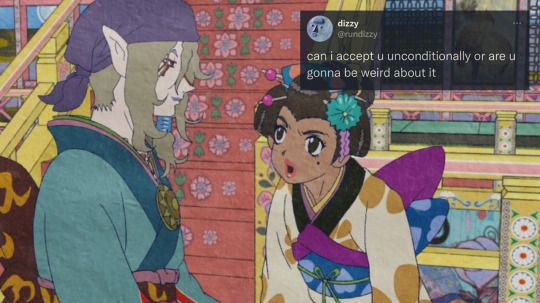


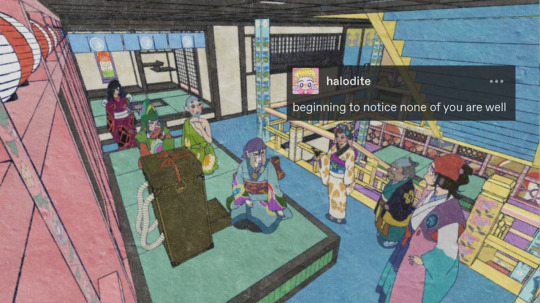



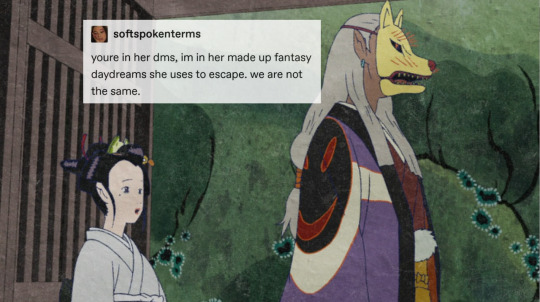

Mononoke (2007) + text posts [round 14]
55 notes
·
View notes
Text
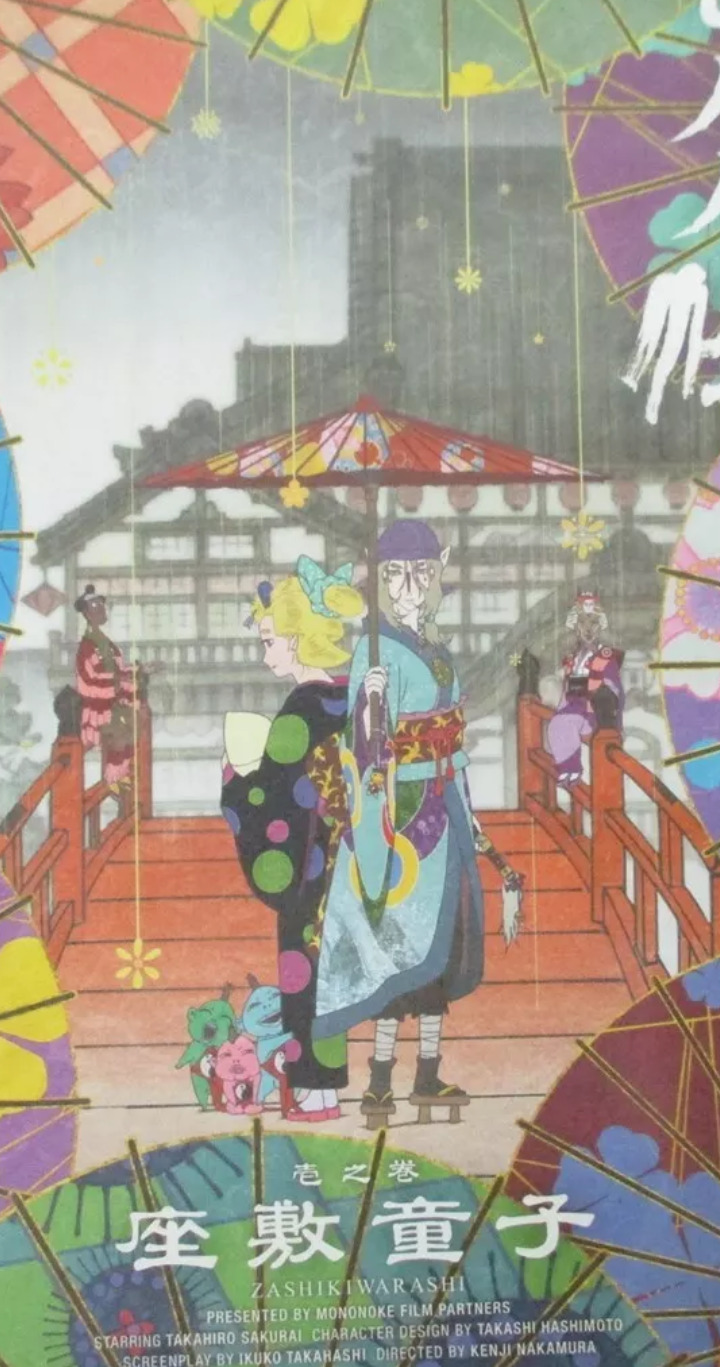
Found while rummaging around on my phone. The more I think about their dynamic the more I love it.
Official DVD cover art.
49 notes
·
View notes
Text
Has anyone seen anything about who the movie's screenwriter is, by the way? The information is either conspicuous by its absence or I'm just missing it.
6 notes
·
View notes
Text
Mononoke's subtext is designed to fold back on itself in an infinite loop; if you ever try to figure it all out you'll have to give up eventually or go insane.
I'm aiming for insane.
#mononoke 2007#kusuriuri#I honestly don't know how the writers accomplished this. I don't know how they did this so well.#human brains shouldn't have this much power
25 notes
·
View notes
Note
pookie are u still alive the 12 people in this fandom are getting revived bcs of the movie
We are ALIVE!

Based on maximum post interactions on just this blog, I estimate the Mononoke fandom population on Tumblr to be somewhere north of 200. We don't do so bad. 😁
When I first watched Mononoke it drove me crazy that there wasn't any more. Never expected that there would be. Yet here we are. Amazing, isn't it?
#mononoke 2007#kusuriuri#asks#the japanese fandom must be huge honestly#based on the fact that mononoke was elected for a 15th anniversary project out of multiple titles#plus the kickstarter funding merchandising etc.#I think it's unusual among anime in that its creators didn't care much about making it palatable to westerners#(I don't know that much about the industry though that's just the impression I get)
62 notes
·
View notes
Text

Quick summary of "Umi Bozu."
53 notes
·
View notes
Text
Can't work today, I'm writing thirty-page essays about my beautiful slutty twink catboy malewife.
20 notes
·
View notes
Text


He doesn't stand like this nearly enough.
#mononoke 2007#kusuriuri#mononoke screencaps#ayakashi bakeneko#love how odajima struggles under the weight of that salt when kayo picks it up and lobs it at a demon with zero effort later#either she's much stronger than she looks or he's way out of shape
40 notes
·
View notes
Text
Y'all, I've had an amazing thought.
I said a while back that the Medicine Seller's alter could be a manifestation of his connection with humans, since his alter is the form that destroys the mononoke, and that power to destroy depends on the Medicine Seller understanding humans.
And as I said in my analysis of Mononoke and feminism, the Medicine Seller's relations with humans occur along a "masculine" to "feminine" axis that's represented by male and female forms, the female/feminine as the creative energy and the male/masculine as the aggressive/destructive. The Medicine Seller's forms mirror the humans'; his usual form is more feminine and his "destroyer" form is more masculine.
But we have every reason to believe that in the movie, the Medicine Seller will be surrounded mostly by women. And instead of the het relationships that are central to almost all of the Mononoke stories, there's (I say) a fair amount of evidence that we'll have a lesbian relationship. So, two sets of "masculine" and "feminine" energies, but both in female forms, no external differentiation.
And if that's true, and the Medicine Seller's alter is male because he mirrors how the "destructive" energy appears around him...
... it's quite possible his new alter form will be a woman.
#mononoke 2007#kusuriuri#mononoke 2024#mononoke theory#I could be wrong though those girls could just be big fans of suggestive hand-holding#I mean the medicine seller is always doing gratuitously sexy stuff with his hands#I WOULD REMARK THOUGH that the whole yin-yang thing I was talking about is really about the bond between apparent opposites#and ''polar opposites'' is exactly how the mononoke movie website describes asa and kame#I'd lay cash money these bitches gay
27 notes
·
View notes
Text

Every shot of the Medicine Seller sitting with his legs tucked under him like a cat is a gift.
49 notes
·
View notes
Note
Please talk about Mononoke's feminist themes! For the record, I already agree; I just love reading your meta commentaries. 💚
Oh, thank you! I also love writing them, and I'm happy when people ask. 🙂
Just a warning, this got very long...
The Role of Daoism
I think at the core of Mononoke's treatment of feminism is the idea that men and women are fundamentally the same, in that the true nature of both is made up of the united "masculine" and "feminine." This view comes from Daoist philosophy, which considers the interdependence of yin (the "feminine") and yang (the "masculine") to be the true nature of all things. The interaction of these complementary energies is the source of all growth and change. Since growth and change are essential to life, the unity of "masculine" and "feminine" is also. In Mononoke, this not only means the life of a society, but also the life within each individual.
The human society in Mononoke is distorted because of the separation it creates between yin and yang. Women are denied their internal "masculine" and assigned only the "feminine" energy of submission and acceptance, while men are driven away from their internal "feminine" and assigned only the "masculine" energy of assertion, aggression, and emotional detachment. The warped social structure in which men control and exploit women depends on this internal alienation of individuals from themselves, and thereby also their external alienation from each other.
These divided "masculine" and "feminine" roles are an unsustainable denial of nature. The confusion and suffering they cause create the mononoke: expressions of the energies humans struggle to suppress. The Bakeneko, the Zashiki Warashi, the Nopperabou are all expressions of the rage that women aren't "supposed" to feel on their own behalf. The Umi Bozu is an expression of the feminine aspect of Genkei that he isn't "supposed" to feel and has come to fear.
Exorcising the mononoke requires drawing out these aspects and reconnecting humans with their real, complete selves. It requires a rebalancing of the "masculine" and "feminine" that gives women back their power and men back their hearts.
Birth As Transformation for Women
An important symbol of this kind of transformation is birth. In western feminism, we're wary (for good reasons) of birth being used to represent feminine power, but it's a central concept in Daoism: The manifestation of all new phenomena depends on the interaction of yin and yang. In Mononoke, childbirth symbolizes the emergence of positive change for women. Giving birth transforms them from static, submissive objects into complete beings who are no longer convenient for men to exploit. Their desire to have their children is a defiance of men's control over them.
This is clear in "Zashiki Warashi," where women are the victims of forced abortions so they can continue to be exploited as prostitutes. Having their children would free these women from prostitution, which not only explicitly treats women like property, but does so in a way that directly reinforces men's power over and lack of empathy toward them.
Unlike the men who use them, these women's children do not embody the alienated "masculine" but the women's own "masculine": parts of themselves that represent their wills and their potential for new and better lives. Their connection with their children is their connection with their true selves, the interlinked yin and yang and the growth and change that emerge from them.
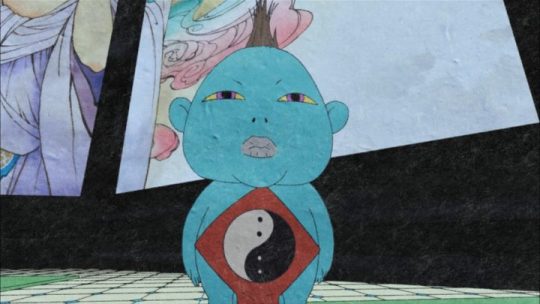
When this "masculine" and the life it would create with them are cut off, they become a mononoke: an expression of the women's grief and rage at the denial of their natures.
Incidentally, their role as symbols of the "masculine" could be why all of the Zashiki Warashi appear to be male.
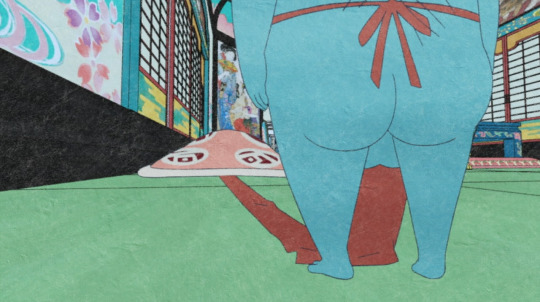
It's kind of subtle though.
This co-operative "masculine" and "feminine" and their power to transform are a threat to the system that relies on women being solely "feminine," submissive and unchanging. Those who depend on that system are desperate to destroy them.
This also happens to Shino: She is used by a man who turns on her the moment she is carrying a child. Shino's child is a threat to this man's power and status, and quite possibly represents a threat to humanity's entire dualistic psychological and social structure.
Shino chooses to embrace her will, her capacity for assertiveness and self-defense, in the face of everyone who tells her she's being "irresponsible" and "selfish." Her "masculinity" protects her, her child, and the potential for change they symbolize.
The themes of prostitution and childbirth that are prominent in "Zashiki Warashi" begin all the way back in the first "Bakeneko" with the way the Sakai family treats Mao. They're not only willing to effectively sell her off to another family in exchange for having their debts covered, but they're selling her to a man who is impotent - who can never give her children. Even before realizing just how badly the women in this society need change, the Medicine Seller recognizes this situation as bad for Mao specifically: he remarks that it's unfortunate for her, with no reference to the man or his family.

The Medicine Seller knows that the denial of childbirth deprives Mao of something that is rightfully hers: her own potential for transformation and growth.
The Alienation of Masculine and Feminine Results in Stasis and Death
"Nopperabou"
Ochou's and Lady Ruri's stories don't use this childbirth metaphor (except perhaps by the absence of childbirth), but these stories also carry the themes of prostitution and death. Ochou is effectively prostituted by her mother, who submits her daughter to men's control in exchange for property. The man Ochou is married to sees women as objects to be purchased and used.
Because Ochou is burdened with a sense of moral obligation (the same form of manipulation used against all the women in "Zashiki Warashi") to fulfill her "feminine" role, she fights against the drive to embrace her own "masculine" - the Nopperabou. The unresolved conflict between her guilt and the need to accept her complete nature traps her in an endless cycle of suffering and death: she lashes out at her abusers but cannot fully integrate her power or escape her mother's manipulation.

This guy's a big help.
Without true unity with her "masculine," Ochou cannot change. Once she understands the root of her guilt, she's able to move past it, and she becomes complete again. Once she's reunified with it, her "masculine" energy serves her real needs - it gives her the strength to leave the cycle of suffering behind, setting her free instead of keeping her trapped. This change finally gives her the "new life" she sought.
The fact that the part of herself that Ochou lost as a child first appears as a duplicate of her shows that this "masculine" is not something separate from her "feminine." Like Genkei and Oyou in "Umi Bozu," Ochou and her "missing half" were together in the beginning, and were never meant to be the separate "male and female" that they appeared to be.
"Umi Bozu"
In "Umi Bozu," Genkei, like Ochou, has been split in two, this time by the rejection of his "feminine" self. He's struggled for years to move on and to reach enlightenment, but he can't let go of the memory of his sister. At the beginning of the arc, Genkei is clearly old and approaching death, but he's realized that he can no longer avoid his sister's memory.
The Medicine Seller equates Genkei's fear of Oyou with a fear of his own heart - perhaps even meaning that they are one and the same. When Genkei's fear is understood as the cause of the mononoke, he literally splits in two. His missing half takes the form of the mononoke, which, when the Medicine Seller exorcises it, becomes a feminine form that literally re-enters Genkei and transforms him. Through the reunification with his "feminine," Genkei dies but is "reborn."

Into a twink.
"Nue"
The "Nue" arc's main theme is stasis and death, and it again explores the use and exploitation of women, men's lack of empathy toward them, and the inescapable connection between them. This arc shows a man's violence toward a woman rebounding on him immediately: Nakarai kills Lady Ruri, finds himself covered in wounds, and dies. Killing her kills him as well.

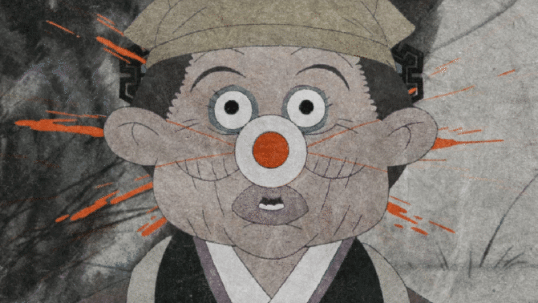
It's quite funny. I mean horrible.
Muramachi and Robou also treat Lady Ruri as nothing more than a tool to get what they want. Their disregard for her life and humanity is so egregious that they rummage around her murdered body looking for the Todaiji they planned to marry her for, and they joke about having a "wedding ceremony" after they compete for its possession. The Medicine Seller, who usually (certainly not always) maintains calm in the face of humans' reprehensible actions, is openly shocked and angry at their behavior.

This guy's whole life is witnessing horrors. If he's looking at you like this, you've truly fucked up.
All three of these men have been trapped in endless stasis and death by their complete focus on their own desires. They see Lady Ruri as nothing more than a conduit for those desires, leaving them utterly disconnected from her humanity.
Their disconnection from her is accompanied by disconnection from themseves, to the point where they're unaware of their own deaths. As with Genkei, accepting those deaths is their only way of escaping them and being "reborn"; otherwise, like Ochou, they remain trapped in an unchanging cycle.
This arc, like the others, implies that all of the men and women in it are interdependent, with each of the female forms of the Nue appearing through the perceptions of each of the men. They appear separate, but neither could exist without the other.
Fear
Genkei's story not only shows stasis and death as a result of his alienation from his sister, but also explores the root cause of men's resistance to their "feminine": fear. The men in Mononoke depend on the isolation of their "masculine" identities for a sense of safety. The identity that Genkei has spent his life building up is defined by pushing away all emotion, all vulnerability - all in an effort to hide from his feelings for his sister. The longer he clings to this isolated self, the stronger his fear becomes.

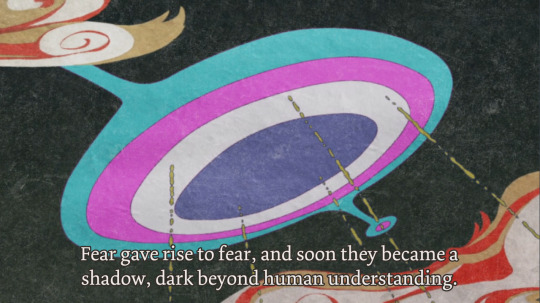
Rejoining Oyou means becoming completely vulnerable, letting her and all the feelings she brings with her inside him. The Medicine Seller tells him that this will kill him, and in a sense it does: His old self is replaced by his "reborn" one.
Facing this fear and embracing the "weakness" of the "feminine" is a profound act of courage, one that makes Genkei stronger and freer. Accepting his "feminine" is his strength.
Unlike Genkei, Sakai and Moriya in "Bakeneko" #1 and #2 never develop this courage. They remain crippled by fear until it destroys them completely. As they continue to deny how much they've hurt women, they become more and more terrified - of women, their own "feminine," and the pain and anger they've poured into them. Their attempts to grasp at safety by rejecting and attacking women make them feel less and less safe as their own inescapable "feminine" and women's inescapable "masculine" demand acknowledgement, growing in power and anger until they become the Bakeneko.
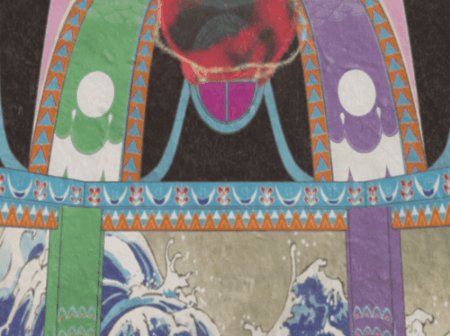

In "Bakeneko" #2, Moriya is the embodiment of the link between misogyny and cowardice; he blatantly exhibits both. Setsuko's will, her "masculine," threatens him with the truth and with the fragility of his status, both in his relationship with her and in society. And Setsuko's "feminine," her more vulnerable emotions, terrify him as well. He can't face these combined aspects of her - and of his - true self, and he is left with abject terror, constantly seeking safety behind his misogyny.


In "Bakeneko" #1, Sakai remains terrified throughout the arc of having to confront his truth. Right up to the last he keeps denying it, and he sits frozen in fear when the Medicine Seller tells him he has to turn around and look at what he's done. Sakai can't face his complete nature, because the schism between the "masculine" and "feminine" in him is so deep that his "masculine" has become a monster and his "feminine" is filled with pain. Acknowledging his real "feminine" would mean feeling what he's done, and acknowledging his real "masculine" along with it would mean fully understanding the horror of what he's become.
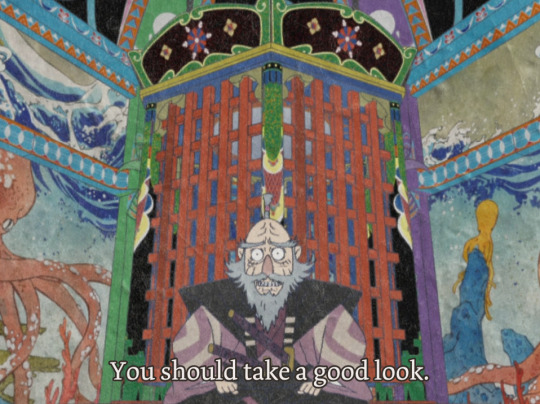
Yeah, asshole.
Unfortunately for Moriya and Sakai, there's no escape from their fear except through the "feminine" - through letting go of their resistance and accepting their destruction. They must die, transform, and be reborn from the cosmic "yin."
This is true for everyone whose internal divisions have created mononoke. The only one who can remain unchanged by the death and rebirth of yin is the one for whom the "masculine" and "feminine" are already unified.

Kind of tickles honestly.
I could say more; I could talk about the Medicine Seller himself; I could talk about how he relates to women and the "feminine" and how much his own path depends on them, but I've said a lot of that before, and I think I've covered the bigger concepts as I see them. There can't be much doubt about Mononoke's feminist themes. Its message is not only that society's treatment of women has historically been grotesque and horrible but that it's a denial of nature, one for which there will always be a price to pay.
#mononoke 2007#kusuriuri#mononoke theory#ayakashi bakeneko#mononoke#mononoke gifs#mononoke screencaps
29 notes
·
View notes
Text
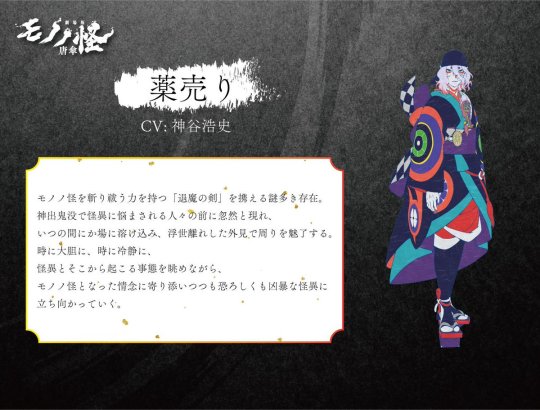
excuse me but kusuriuri's game in this design is unfathomable???

[x]
123 notes
·
View notes
Text
In discussing Mononoke's treatment of feminism, I honestly don't feel the need to mention that the Medicine Seller is a femboy, because if you watched Mononoke and didn't pick up on the fact that the Medicine Seller is a femboy, you clearly didn't watch Mononoke.
#mononoke 2007#kusuriuri#i mean you can miss a lot of stuff in mononoke but you can't miss that#this analysis is getting loooong#some time I want to talk about why the medicine seller is a guy (mostly?...) but that's a whole other essay
45 notes
·
View notes
Text
Is monoke a dead fandom? Does it have a fandom? Does it matter? NO

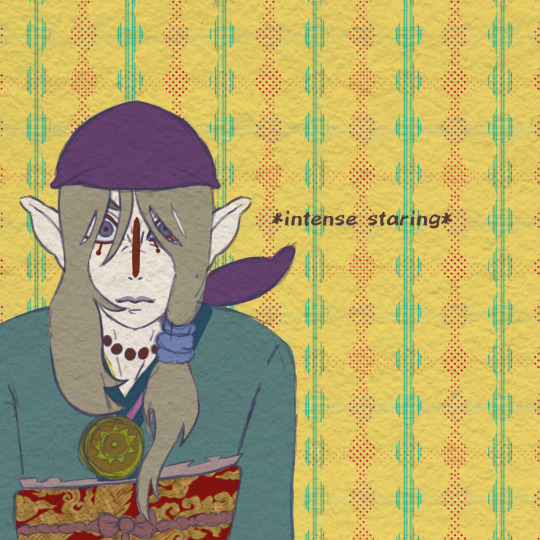

68 notes
·
View notes
Text

Two kinds of guy.
#mononoke 2007#mushishi#kusuriuri#ginko#just had to get this out of my head#for the record they are both valid
322 notes
·
View notes